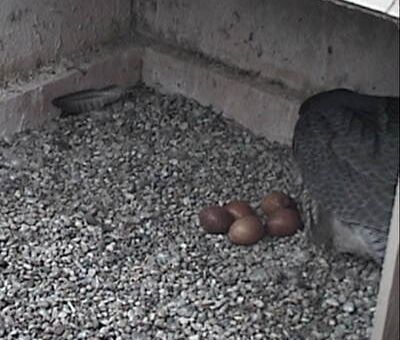
It looks to me like the egg at top right has a pip in it. See the dent?
This photo is from last evening at 7:50pm, so perhaps this egg will hatch today.
(photo from the National Aviary webcam at University of Pittsburgh)

It looks to me like the egg at top right has a pip in it. See the dent?
This photo is from last evening at 7:50pm, so perhaps this egg will hatch today.
(photo from the National Aviary webcam at University of Pittsburgh)
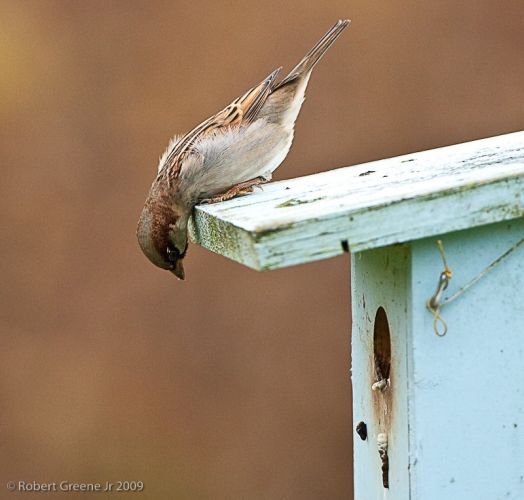
For those who love bluebirds, the sight of a house sparrow eyeing a bluebird box is both maddening and frightening.
House sparrows are cavity nesters, just like bluebirds, but they are far more aggressive. They are so territorial that they’ll claim multiple boxes and exclude all others from nesting even though they can’t possibly use them all. What’s worse is that male house sparrows will kill adult bluebirds inside the nest box and peck the chicks to death as part of this territorial behavior.
Many are the sad stories of house sparrow attacks and dead baby bluebirds. Beakless Bluebirds and Featherless Penguins by Sister Barbara Ann tells of the success she had in raising two beakless bluebirds who survived an attack thanks to her care. Not everyone has the time or skill to do this.
As bluebird monitors will tell you, there is no real way to exclude house sparrows because they are nearly the same size as bluebirds. The only effective method is to trap every house sparrow and remove it. It is illegal to trap native birds without a permit, but house sparrows are non-native and invasive. They can be trapped and removed.
There are many Internet resources that explain how to do this. Try the Bluebird Society of Pennsylvania and Sialis.org for starters.
Right now is bluebird nesting season. It’s time to trap this house sparrow.
Hey you, House Sparrow! Get away from that box! Don’t you even think of it!
(photo by Bobby Greene)
The peregrine eggs at the University of Pittsburgh’s Cathedral of Learning have not hatched yet as of 7:24am (Eastern Daylight Time). Watch the streaming camera here.
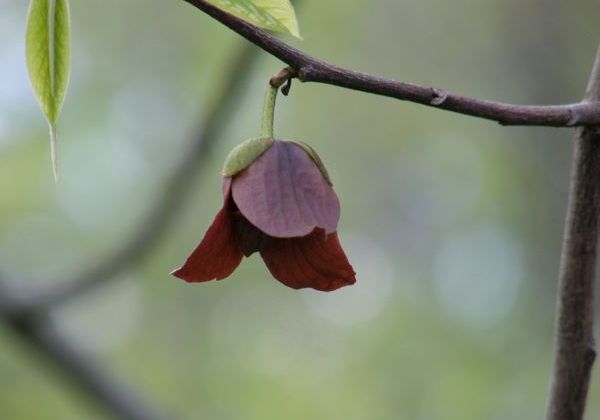
Here is a most unusual flower that hangs like a bell, sometimes in rows.
It has three deep maroon petals, three green sepals, and if you look inside three curled maroon petals surround the pistil. The flowers are small when they first bloom, but grow to two inches long.
This is the flower of the Common Pawpaw tree (Asimina triloba), blooming right now in western Pennsylvania.
Though named “common,” pawpaw is an uncommon understory tree that grows in hardwood forests and bottomlands. I found pawpaw trees blooming last weekend in Schenley Park and at Enlow Fork.
Some people prize pawpaw for its 4-inch long lumpy fruit that has the consistency of mangoes and the taste of bananas. I ought to like it, but I’m not fond those two tropical fruits. If you try it, don’t eat the seeds (see the link above).
I was able to identify the flower because Marcy Cunkelman sent me this photo a year ago. When I saw the pawpaw blooming I remembered her picture but not the name of the tree, so I looked it up when I got home. Thanks, Marcy!
(photo by Marcy Cunkelman)
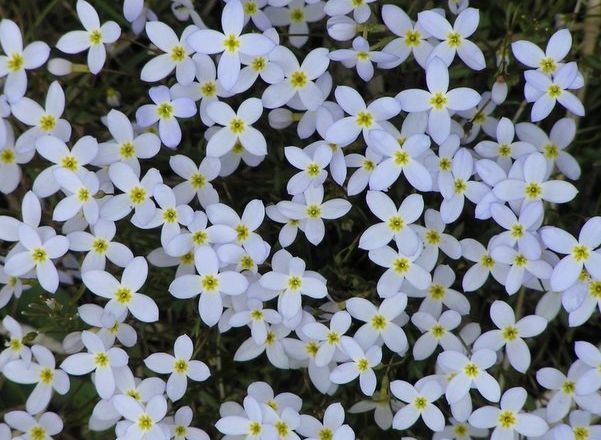
Bluets (Houstonia caerulea) are one of my favorite flowers. Where they grow well, they form a pale blue carpet. Don’t mow them!
(photo by Dianne Machesney)
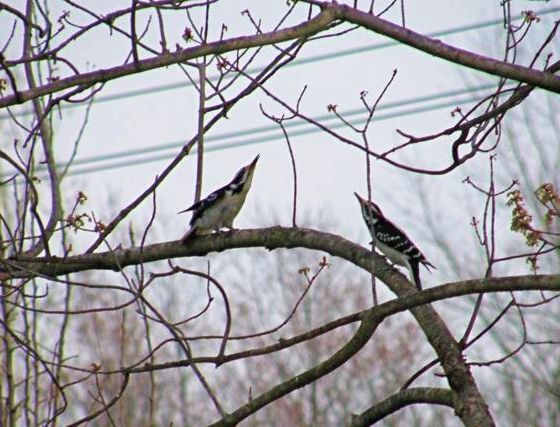
When I was a kid, Saturday afternoon TV often showed swashbuckling movies starring Errol Flynn as Robin Hood or Captain Blood.
“En garde!” he’d shout and draw his sword.
That’s what these hairy woodpeckers are doing.
“Mine!” they’re saying to each other. “Go away!”
According to Birds of North America, hairy woodpeckers use their bills when establishing their nesting territories. (I’ve paraphrased it here.) “In close encounters, they use a bill-waving display that includes jerky body movements and waving their raised bills as if dueling. The birds may stop for a minute or more, remaining motionless, each with its body pressed against the tree trunk and bill pointed forward and slightly raised as if crouched for attack or defense.”
Marcy Cunkelman found these two fighting in her yard this month. I don’t know how the contest ended but I know the fight was worth it. Marcy’s yard is a rich wonderland for birds.
(photo by Marcy Cunkelman)
After 30 hours down, the streaming camera at the University of Pittsburgh’s Cathedral of Learning is up again –> http://www.aviary.org/cons/falconcam_cl.php
It was an adventure. 🙂
 For several weeks we’ve learned about body parts that are the same on birds and humans. Today’s lesson is very different.
For several weeks we’ve learned about body parts that are the same on birds and humans. Today’s lesson is very different.
The cloaca is a bird anatomy part most people never see. It’s under the bird and usually covered by feathers.
Cloaca (pronounced klo-A-ca) is a Latin word that means “to cleanse” and is aptly used to name the bird’s single opening for its urinary, intestinal and reproductive tracts. Here it is on a great egret, circled in pink.
This multi-purpose “vent” may seem odd but male mammals have a single opening for urine and semen. Birds economize further. Everything happens at one location for them.
When birds mate, they touch their cloacas for a few seconds. This brief “cloacal kiss” is just enough time to transfer semen to the female.
If you don’t like the sound of “cloaca” you can use the word “vent,” a prettier, alternative name.
(photo of the underside of a great egret, including cloaca, by Chuck Tague)
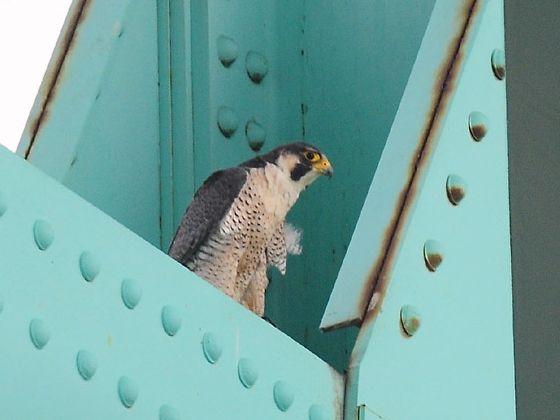
If you’ve been watching the peregrines at the University of Pittsburgh’s Cathedral of Learning, you may have the false impression that all peregrines are incubating right now and their eggs will soon hatch.
Not so.
Some peregrines, even in Pittsburgh, are still laying eggs. That’s what Steve Gosser found out in Tarentum last Sunday after a chain of events that put him at the bridge with his camera at just the right moment.
It started last December when Dan Yagusic identified a pair of peregrines at the Tarentum Bridge. Steve confirmed the same pair in February. Then I visited the bridge April 4 and after a boring hour of nothing but pigeons, I was rewarded with 10 seconds of excitement: a peregrine loudly chased a red-tailed hawk away from the bridge. That bird must be nesting there!
On the strength of these observations Steve visited the bridge last Sunday hoping to photograph the falcons. He only had to wait 10 minutes before they appeared, courting loudly. They flew away but soon returned and mated on a bridge beam. Steve took a lot of pictures.
Peregrines mate prior to egg laying and until incubation begins, so this pair hadn’t completed their clutch yet.
I hope they’re successful. You see, I have a special interest in them. The male was born at the Cathedral of Learning in 2008, the son of Dorothy and E2, so his babies will be their “grandkids.” Oh boy!
(photo by Steve Gosser)
Last year, WQED’s Web Department made three videos for me to post on my blog: An April Hike at Raccoon Creek State Park, the Pitt Peregrine Fledge Watch, and a third (not yet edited) film of Marcy Cunkelman’s garden in August.
Though it was filmed last year on April 23, the Web Department had to wait until their summer intern, Christa Majoras, was available to edit it. Christa did a fine job and completed the video in July, but by then these scenes of April were out of season so I saved the video for this week.
My plan was to show you a preview of flowers-to-come but life is full of twists and turns. Who could imagine we’d have a spring so warm that the plants would be two to three weeks ahead of schedule? This video is again out of season — late by two weeks.
Use your imagination as you watch. Go back in time to March 31 and remember what the landscape looked like. Or watch this video for signs of just how far ahead this spring is compared to April 2009.
Sit back and enjoy An April Hike.
(video filmed by Joan Guerin, edited by Christa Majoras)
note\\flashvideo file=”https://www.birdsoutsidemywindow.org/video/april_hike_7-16-09.flv” image=”http://www.birdsoutsidemywindow.org/wp-content/uploads/2010/04/kate_AprilHike_video3.jpg” /